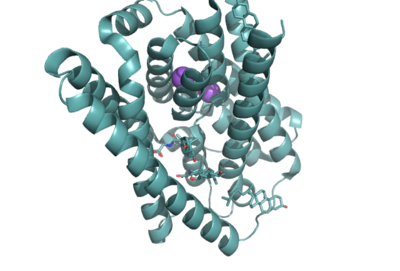Sandbox Reserved 1782
From Proteopedia
(Difference between revisions)
| Line 5: | Line 5: | ||
== Background == | == Background == | ||
[[Image:7ZYIbound.png|400 px|right|thumb|'''Figure 1.''' NTCP structure with both Na ions and bile salts bound. PDB file 7ZYI.]] | [[Image:7ZYIbound.png|400 px|right|thumb|'''Figure 1.''' NTCP structure with both Na ions and bile salts bound. PDB file 7ZYI.]] | ||
| + | *Sodium taurocholate co-transporting polypeptide (NTCP) is a sodium-dependent transporter in the body that is responsible for the transportation of bile salts from the blood into epithelial liver cells. Both sodium ions and bile salts bind to NTCP in the same binding pocket on the molecule (Fig. 1). NTCP also acts as a receptor for Hepatitis B virus and Hepatitis D virus. | ||
| + | *The bile salts transported by NTCP are located within the gastrointestinal tract of the body and play a very key role in many biological functions. These functions include digesting and absorbing nutrients by helping break down fats and transporting lipid soluble nutrients into the liver. | ||
=== Structural Overview === | === Structural Overview === | ||
Revision as of 20:14, 13 March 2023
| This Sandbox is Reserved from February 27 through August 31, 2023 for use in the course CH462 Biochemistry II taught by R. Jeremy Johnson at the Butler University, Indianapolis, USA. This reservation includes Sandbox Reserved 1765 through Sandbox Reserved 1795. |
To get started:
More help: Help:Editing |
human Sodium Taurocholate Co-transporting Polypeptide (NTCP) structure
| |||||||||||
References
Student Contributors
- Kenna King
- Tatiana Pereda
- Olivia Simcox

